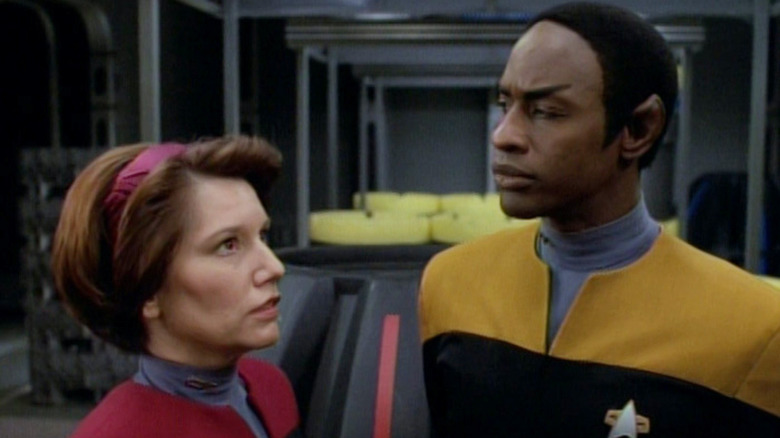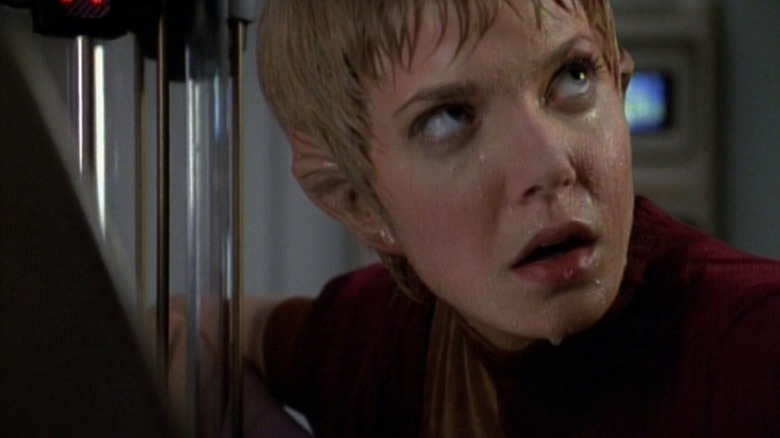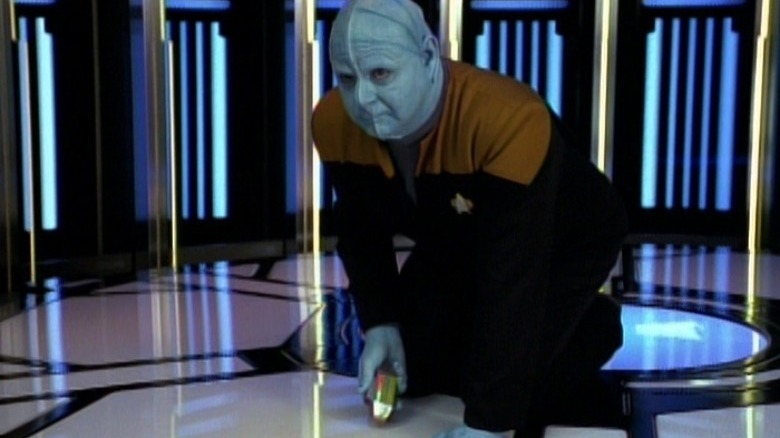Why Star Trek: Voyager's First Season Never Got A Proper Finale
The final episode of the third season of "Star Trek: The Next Generation" was called "The Best of Both Worlds" (June 18, 1990), and it is often celebrated as one of the best episodes of the series. Notably, the episode ended on a humdinger of a cliffhanger, revealing that Captain Picard (Patrick Stewart) had been assimilated by the Borg. Trekkies had to wait until September 24 to see the conclusion.
This two-parter kicked off a long-standing "Star Trek" tradition of ending every season of every show with a notable cliffhanger. The remaining "Next Generation" seasons always left viewers with something to anticipate through the summer. There was an exception at the end of the first season of "Star Trek: Deep Space Nine," which ended on a usual note, but the show's second season opened with an unprecedented three-part episode, so it feels like it counts.
The finale of the first season of "Star Trek: Voyager" was nothing to write home about. The episode was called "Learning Curve" (May 22, 1995), and it was about several Maquis officers who had been conscripted into the Voyager crew after their ship was destroyed. Tuvok (Tim Russ), who used to live with them undercover, has to train them to be better Starfleet officers. Also, the ship's environmental controls go haywire after Neelix (Ethan Phillips) tries to make cheese (!) and accidentally infects the ship's organic computer components with a virus. It's nothing special or notable.
It turns out that the finale ... wasn't a finale. It was merely the final episode of the season by a fluke of programming. The schedule of the first season of "Voyager" was detailed in the oral history book "Captains' Logs Supplemental: The Unauthorized Guide to the New Trek Voyages," edited by Mark A. Altman and Edward Gross.
Voyager season 1's final episodes were held back by UPN
"Star Trek: Voyager," it should be noted, began with a truncated season of only 15 episodes. Most pre-streaming "Star Trek" shows ran a whopping 26 episodes a season. It was considered very usual at the time (at least among Trekkies) to have so few Treks at once. "Voyager" was the flagship series for the UPN, a network that launched at the same time as the then-new "Star Trek" show, and it seemed that the network had a lot more control over how the series was exhibited. "Voyager" co-creator and writer Jeri Taylor recalled working on four additional episodes for the first season, only to learn that the UPN had decided to hold them back for season 2:
"It's very important to note that we didn't hold back any of the episodes, UPN did. [...] It's important that people start understanding that there is a significant difference at this point between the network and the studio. The studio produces the television series, and the network buys it and runs it as they would from any other studio. The network has control over when and how they schedule the episodes. We and Paramount and the studio were not in accord with that decision to hold back episodes, but it was UPN's right to do so."
UPN did have a reason for scheduling "Voyager" the way they did, but it didn't make sense to Taylor. In fact, Taylor hated the decision to end season 1 with "Learning Curve." Not because of the content of the episode, but because that would be four additional weeks the network would need to lean on reruns.
UPN wanted Voyager season 2 to premiere early
Taylor noted:
"... [B]y summer we were having the third run of some shows, giving the impression that people are seeing the same shows over and over again and that there is no fresh programming. I would much rather they had used those extra four episodes to provide more fresh programming so the audience wouldn't feel the show had gotten stale in its first season. Also, we had planned those for shows as a build that would take us out of the first season on a triumphant, uplifting note. As it was, the season just ends."
Lucy Salhany, the head of UPN, was also quoted in "Captains' Logs Supplemental." She explained that premiering "Voyager" season 2 early was more important that concluding season 1 in a meaningful way. The first episode of the second season, "The 37s," aired on August 28, 1995, whereas all the other major networks waited until mid-to-late September to start their respective seasons. In her own words:
"I didn't want to wait until the middle of September, when all the other networks –- the 'big' networks –- are premiering. [...] In order to do that, we needed to hold some episodes back. The shows that we held back would have run two in June and two in July. They would not have run earlier because they wouldn't have been done to go on in May. So, we've had some reruns. We knew that was going to happen."
Which makes sense. "Voyager" co-creator Michael Piller was okay with Salhany's release schedule and noted that Salhany had great success with it when she worked for Fox. Also, "Voyager" only had a total of 20 episodes when it began airing, so holding a few back made everyone's lives easier.
The reruns were a little annoying, though.


